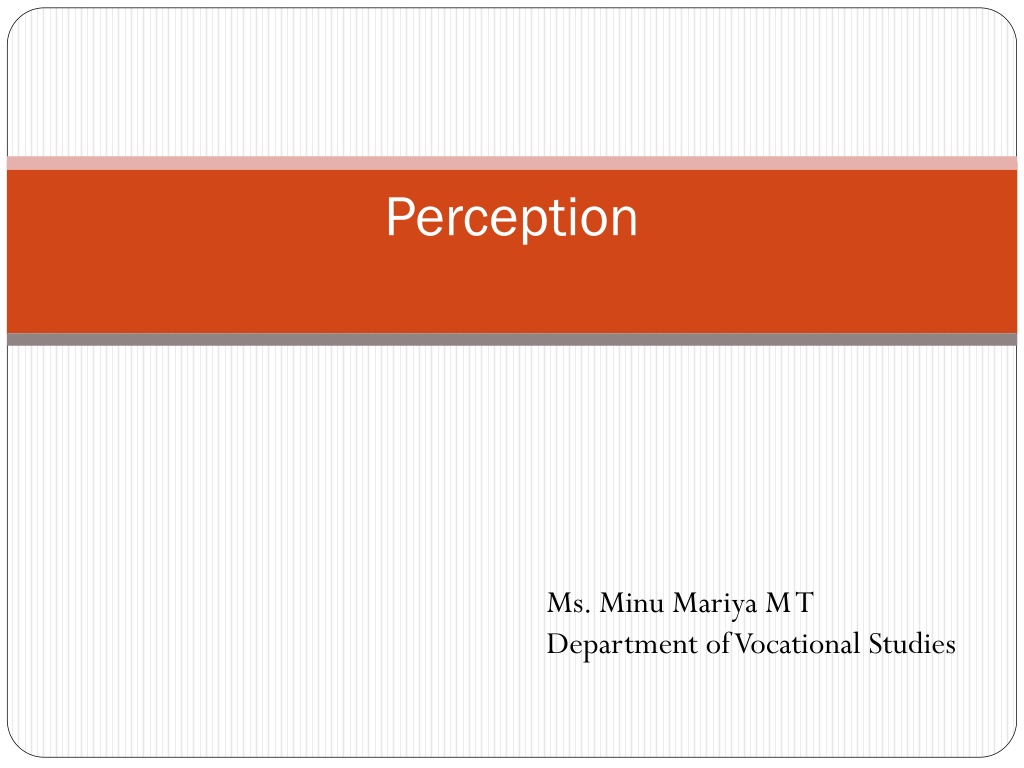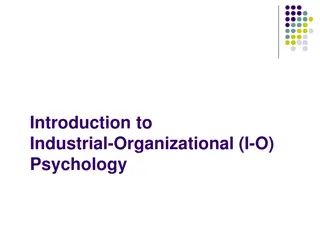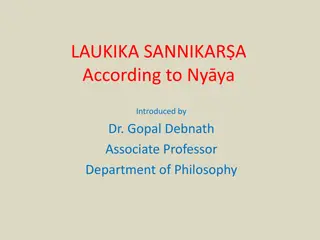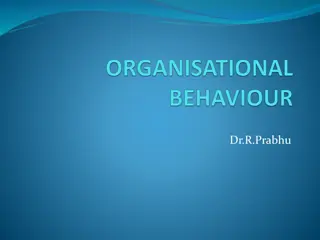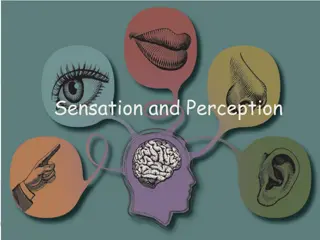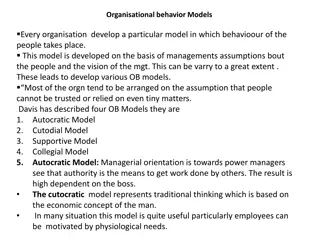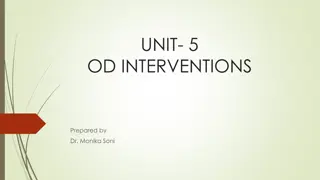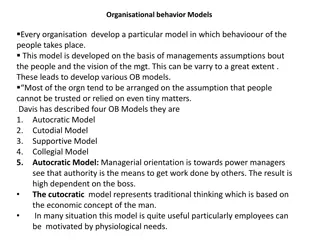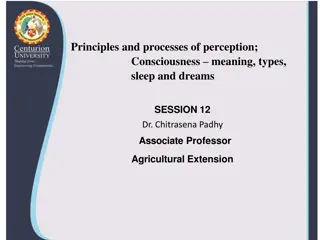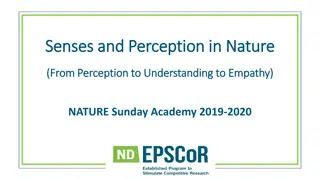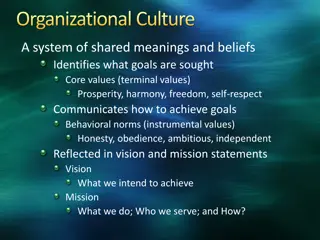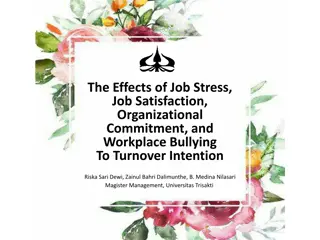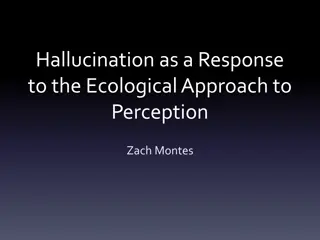Understanding Perception in Organizational Behavior
Perception, as the process of interpreting sensory information, plays a crucial role in individual behavior within organizations. This article delves into the basics of perception, highlighting its impact on how individuals view reality, receive information, and make interpretations. It also explores the factors influencing perception, such as external stimuli, internal motivations, and organizational messages. Understanding perceptual processes can help managers address distortions and better communicate with their team members to achieve organizational goals effectively.
Download Presentation

Please find below an Image/Link to download the presentation.
The content on the website is provided AS IS for your information and personal use only. It may not be sold, licensed, or shared on other websites without obtaining consent from the author. Download presentation by click this link. If you encounter any issues during the download, it is possible that the publisher has removed the file from their server.
E N D
Presentation Transcript
Perception Ms. Minu Mariya M T Department of Vocational Studies
Introduction Perception is described as a person s view of reality. Perception is an important mediating cognitive process. Through this complex process, people make interpretations of the stimulus or situation they are faced with. Both selectivity and organization go 'into perceptual, interpretations. Externally, selectivity is affected by intensity, size, contrast, repetition, motion and novelty and familiarity. Internally, perceptual selectivity is influenced by the individual's motivation, learning and personality. After the selective process filters the stimulus situation, the incoming information is organized into a meaningful whole. It is the interpretation of sensory data so as to gather meaningful ideas . In the process of perception, people receive many different kinds of information through all five senses, assimilate them and then interpret them. Different people perceive the same information differently.
Perception plays a key role in determining individual behaviour in organizations. Organizations send messages in a variety of forms to their members regarding what they are expected to do and not to do. In spite of organizations sending clear messages, those messages are subject to distortion in the process of being perceived by organizational members. Hence, managers need to have a general understanding of the basic perceptual process.
Basic Perceptual Process Perception is influenced by characteristics of the object being perceived, by the characteristics of the person and by the situational processes. Perception is a screen or filter through which information passes before having an effect on people. It consists of: 1. Perceptual input- Information, object, event, people, symbols etc. Characteristics of the object include contrast, intensity, movement, repetition and novelty. Characteristics of the person include attitude, self-concept and personality. 2. Perceptual mechanism- receiving of information by means of five senses from the external environment and process them to form output. It includes: a. Perceptual receiving b. Perceptual selectivity c. Perceptual organization d. Perceptual Interpretation (perceptual context, perceptual defense, halo effect, projection, attribution, stereo typing etc.) 3. Perceptual output- behavioral outcome of perceptual mechanism. It is the result of perceptual process. It includes attitude, opinions, feelings, values and behaviour
Perception Perceptual context Sometimes visual stimuli will be completely meaningless without context. In organization, a pat on the back, a suggestive gesture, a raised eyebrow etc. will be meaningless without proper context. They will be made more meaningful if an employee receives a pat on the back for enhancement of his performance and like that. Perceptual defense People often screen out perceptual stimuli that make them uncomfortable and dissatisfying people generally build defenses against stimuli or events that are either personally or culturally unacceptable or threatening. Perceptual defence is performed by a. Denying the existence or importance of conflicting information. b. Distorting the new information to match the old c. Acknowledging the existence of new information but treating it as a non- representative exception.
Selective Perception Selective perception is the process of screening out information that we are uncomfortable with or that contradicts our beliefs. For example, a manager has a very positive attitude about a particular worker and one day he notices that the worker seems to be goofing up. Selective perception may make the manager to quickly disregard what he observed. For example, a manager who has formed a very negative attitude about a particular worker and he happens to observe a high performance from the same worker. In this case influenced by the selective perception process he too will disregard it. In one sense, selective perception is beneficial because it allows us to disregard minor bits of information. But if selective perception causes managers to ignore important information, it can become quite detrimental.
Halo Effect It is the tendency of judging the person entirely on the basis of a single trait which may be favourable or unfavourable. We judge a person by our first impression about him or her. When we draw general impression about an individual based on single characteristics such as intelligence, sociability or appearance, a halo effect is operating. This phenomenon frequently occurs when students appraise their classroom teacher.
Projection It refers to the tendency of the people to see their on traits in other people. It means that when they make judgments about others, they project their own characteristics in others.eg. For a lazy supervisor, every worker is lazy or idle Attribution Perception is also closely linked with another process called attribution. Attribution is a mechanism through which we observe behaviour and then attribute certain causes to it. According to Attribution theory, once we observe behaviour we evaluate it in terms of its consensus, consistency and distinctiveness. Consensus is the extent to which other people in the same situation behave in the same way. Consistency is the degree to which the same person behaves in the same way at different times. Distinctiveness is the extent to which the same person behaves in the same way in other situations. The forces within the person (internal) or outside the person (external) lead to the behaviour. For
Impression Management Social perception is concerned with how one individual perceives other individuals. Conversely, impression management is the process by which the general people attempt to manage or control the perceptions that others form about them. People often tend to present themselves in such a way so as to impress others in a socially desirable manner. Thus, impression management has considerable' implications for activities like determining the validity of performance appraisals. It serves as a pragmatic, political tool for someone to climb the ladder of success in organizations.
Factors Affecting Perception Perceptual selection is determined by two broad factors: 1. External factors 2. Internal factors
External Factors A. Size size determines the height or weight of an individual, object etc. bigger the size, higher will be the perception . B. Intensity- intensity attracts to increase the selective perception. Eg. An illuminated shop attracts attention of the customers. C. Repetition- repeated message and advertisement is more likely perceived than a single one. D. Movements moving objects are more likely to be perceived than a stationary object. A moving car is more perceived than a parked car
External Factors F. Status- high status people can influence the perception of employees than low status people. An order from the Managing Director may be perceived by employees quickly. G. Contrast - an object which contrasts with surrounding environment is more likely to be noticed. E.g. EXIT sign in the cinema hall, Danger sign in transformers etc. H. Novelty and Familiarity- this states that either the familiar or novel factor can serve as attention better. E.g. Face of a film star can be identified even in a crowd. Novel or new type of advertisement like DOCOMO
External Factors I. Nature perception level may be varied according to the nature of input or stimuli. Eg. A picture attracts more attention than a word. J. Order- the order in which the objects or stimuli are presented is an important factor for attention. E.g. Welcome speech at the beginning will attract more attention. Like that, in film, suspense will be revealed at last to heighten the curiosity and perceptive attention.
Internal Factors A. Learning- A perceptual set is basically what a person expects from the stimuli on the basis of experience and learning relative to same or similar stimuli. Eg. Perception on sign board will be different for those who learned driving and those who not. Motivation- Motivation also plays an important role in influencing perception. E.g. A hungry person will be very sensitive to the smell or sight of food than a non-hungry one. B. Personality- perception is also influenced by personality especially young and old, man to women etc. C. Experience-a successful experience enhance and boost the perceptive ability and leads to accuracy in perception whereas failure erodes confidence
